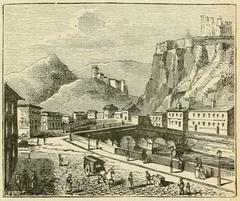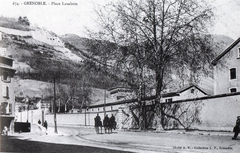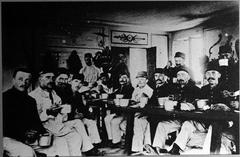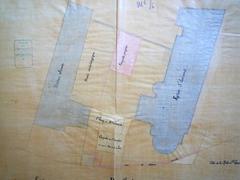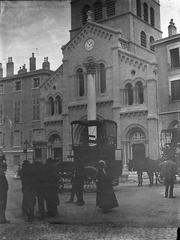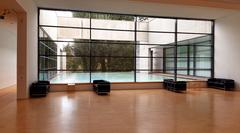
Chapelle du Couvent des Minimes de Grenoble: Visiting Hours, Tickets, and Historical Site Guide
Date: 03/07/2025
Introduction: Chapelle du Couvent des Minimes – History and Cultural Significance
Located in the heart of Grenoble, France, the Chapelle du Couvent des Minimes stands as a remarkable testament to the city’s layered religious, architectural, and cultural history. Founded in the late 15th century by the Minim Order—established by Saint Francis of Paola—the site has evolved through periods of spiritual devotion, royal endorsement, revolutionary change, and modern revitalization. Today, the chapel and its adjoining convent serve as both historical monument and dynamic cultural center, bridging five centuries of tradition with contemporary community life. Visitors will discover not only the architectural beauty of the chapel and cloister but also a vibrant hub for concerts, exhibitions, coworking, and social gatherings (Patrimoine Grand Grenoble PDF; Grenoble Tourisme; Musée dauphinois).
Contents
- Discover the Chapelle du Couvent des Minimes: A Historical and Cultural Gem
- Foundations and Early History
- Architectural Evolution and Features
- Social and Religious Role
- Impact of the French Revolution and Secularization
- Modern Transformations and Cultural Renaissance
- Visiting Information
- Visiting Hours and Tickets
- Accessibility and Facilities
- Getting There
- Special Events and Guided Tours
- Nearby Attractions
- FAQs
- Architectural Overview
- Structural Elements and Materials
- Artistic Features and Programming
- Adaptive Reuse and Transformation
- Modern Amenities and Cultural Hub
- Preservation and Heritage Status
- Site Access, Navigation, and Practical Tips
- Facilities and Accessibility
- Highlights and Photographic Spots
- Visitor Guidelines
- Summary and Final Tips
- Sources
Discover the Chapelle du Couvent des Minimes: A Historical and Cultural Gem
Foundations and Early History
The Chapelle du Couvent des Minimes is intrinsically connected to the arrival of the Minim Order in the Dauphiné region. The Minims, a mendicant order founded by Saint Francis of Paola, settled near Grenoble in 1496, following a pivotal encounter between Bishop Laurent Alleman and the saint (Patrimoine Grand Grenoble PDF). Their initial foundation at Saint-Martin-d’Hères served both religious functions and as the burial place of notable figures, including Chevalier de Bayard (Wikipedia).
In the 17th century, the Minims established a new convent in Grenoble’s Très Cloîtres neighborhood, supported by royal patronage and letters patent from Louis XIV (Grenoble Patrimoine). Construction began in 1644; by 1652, the complex was complete, providing spiritual and social services in a growing urban center (Peace Reporter).
Architectural Evolution and Features
The convent’s buildings are arranged around a central cloister, with the chapel forming one wing. The architecture reflects 17th-century classical style, using local materials such as river pebbles and Sassenage stone. Notable features include:
- Semicircular arcades and dressed stonework in the cloister
- A grand staircase with stone balustrades
- A classical limestone façade for the chapel
The chapel’s acoustics and proportions have made it an ideal venue for music, now hosting renowned ensembles like Les Musiciens du Louvre (Wikipedia).
Social and Religious Role
Throughout its history, the convent served both contemplative and charitable purposes, offering refuge and aid to the poor of Grenoble (Peace Reporter). Its location near the bishop’s palace fostered collaboration with other ecclesiastical institutions, making it a cornerstone of the city’s spiritual and civic life.
Impact of the French Revolution and Secularization
The French Revolution brought dramatic change: the Minims were expelled, the property nationalized, and the buildings repurposed for civic uses such as a grand seminary and later the city conservatory (Wikipedia; Grenoble Patrimoine). The chapel was preserved and found new life as a cultural venue.
Modern Transformations and Cultural Renaissance
Since the early 21st century, the site has undergone significant revitalization. Managed by local social enterprises and supported by city authorities, the convent has become a vibrant “tiers-lieu” (third place), balancing heritage conservation with modern usage (Peace Reporter; Le Dauphiné). The vast outdoor spaces host concerts, festivals, and exhibitions, while interior spaces house coworking areas, a café, and the Salle Olivier Messiaen auditorium.
Visiting the Chapelle du Couvent des Minimes: Essential Information
Visiting Hours and Tickets
- Chapel & Cultural Spaces: Open during special events and guided tours.
- Minimistan Café & Restaurant: Monday–Friday, 8:00–00:30; Saturday, 9:00–00:30 (Petit Futé).
- Admission: General access to public areas is free; tickets may be required for concerts, exhibitions, or guided tours. Refer to the official Grenoble Tourisme website for up-to-date schedules and pricing.
Accessibility and Facilities
- Accessibility: The main site is wheelchair accessible, with ramps and elevators. Assistance can be arranged on request.
- Amenities: On-site café/restaurant, coworking spaces, library, and restrooms available (Petit Bulletin).
Getting There
- Address: Rue du Vieux Temple, Grenoble city center
- Public Transport: Tram lines A & B (stops nearby); multiple bus connections
- Parking: Ample public parking available within walking distance
Special Events and Guided Tours
Regular cultural events include concerts, art exhibitions, and festivals. Guided tours are offered, especially during European Heritage Days and special programs. Private group tours can be arranged via the official website.
Nearby Attractions
- Bastille Fortress: Accessible by cable car, with panoramic city views
- Musée de Grenoble: Renowned art museum nearby
- Saint-Laurent District: Historic neighborhood with dining and archaeological sites
Architectural Overview
Structural Elements and Materials
- Masonry: River pebbles and Sassenage stone typical of the Dauphiné region (isère-annuaire.com)
- Cloister: Arcaded galleries, columns with round shafts, Sassenage stone paving
- Sacristy: Clay tile flooring, ribbed vaults
- Bell Tower: The only remaining vertical element of the original church
Artistic Features and Programming
- Interior: Austere, reflecting the Minims’ values, but with vaulted ceilings and excellent acoustics
- Adaptive Reuse: Salle Olivier Messiaen auditorium for music and arts (grenoble-tourisme.com)
- Cultural Events: Annual “Esprit Nomade” festival and rotating art installations (Petit Bulletin)
Preservation and Heritage Status
- Monument Historique: Listed since 1908 (POP Culture Gouv)
- Conservation: Restoration projects aim to preserve original features and architectural integrity while enabling modern use
Site Access, Navigation, and Practical Tips
Location and Approach
The site is centrally located and easily accessible by foot, bicycle, or public transport. For a more adventurous visit, the Chapelle du Couvent Sainte-Marie-d’en-Haut (part of the same Minims heritage) is perched on Rabot hill and accessed via the montée Chalemont staircase—rewarding visitors with stunning city and mountain views (Merveilles cachées).
Facilities and Accessibility
- Main Complex: Fully accessible; modern amenities available
- Historic Chapel (Sainte-Marie-d’en-Haut): Not fully accessible due to stairs and historic constraints; contact museum staff for assistance
Highlights and Photographic Spots
- Cloister and Grand Staircase: Excellent for photography
- Baroque Frescoes & Gilded Retable: In Sainte-Marie-d’en-Haut chapel, crafted by Toussaint Largeot
- Terrace at Minimistan: Spacious outdoor setting for relaxation and events
Visitor Guidelines
- Photography: Permitted without flash
- Conduct: Respectful silence requested inside sacred spaces
- Dress Code: Informal, but respectful attire appreciated
Frequently Asked Questions (FAQs)
Q: Are tickets required for entry?
A: General access is free; some events/tours require tickets.
Q: Are guided tours available?
A: Yes, especially during special events. Check the official website for schedules.
Q: Is the chapel wheelchair accessible?
A: The main complex is accessible; some historic areas (e.g., Sainte-Marie-d’en-Haut) may not be fully accessible.
Q: Can I take photos inside?
A: Yes, but flash photography is not allowed.
Q: Are there dining options on-site?
A: Yes, the Minimistan café and restaurant are open to visitors.
Summary and Final Tips
The Chapelle du Couvent des Minimes in Grenoble is a unique destination that merges centuries of religious, architectural, and social history with dynamic modern uses. Whether you’re interested in history, art, music, or simply a beautiful place to relax, the chapel and its surroundings provide an enriching experience. For the best visit:
- Check official websites for updated hours and event info
- Take advantage of guided tours for deeper insight
- Explore nearby attractions in Grenoble’s historic center
- Consider accessibility needs if visiting historic chapels requiring stairs
Stay connected for updates through the official tourism websites and the Audiala app.
Sources
- Patrimoine Grand Grenoble PDF
- Grenoble Tourisme
- Petit Futé
- Merveilles cachées
- Peace Reporter
- Le Dauphiné
- actu.fr
- isère-annuaire.com
- Petit Bulletin
- POP Culture Gouv







